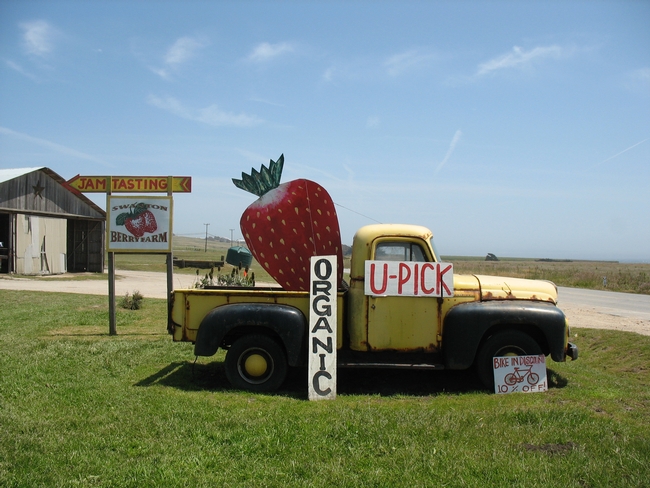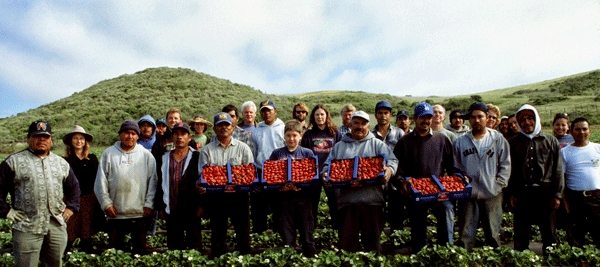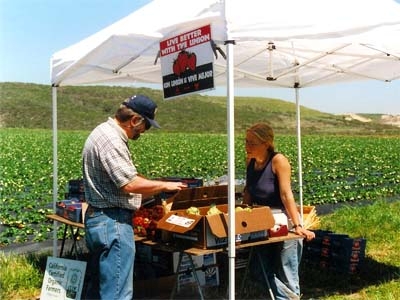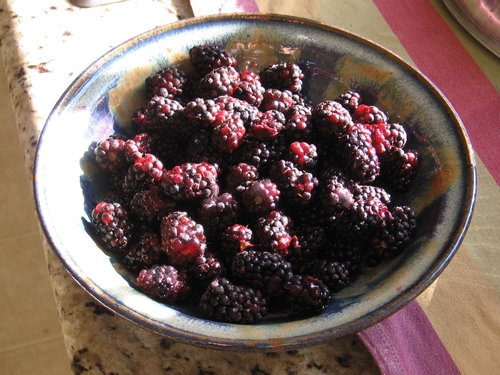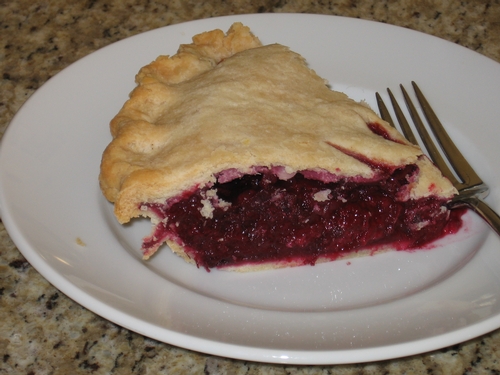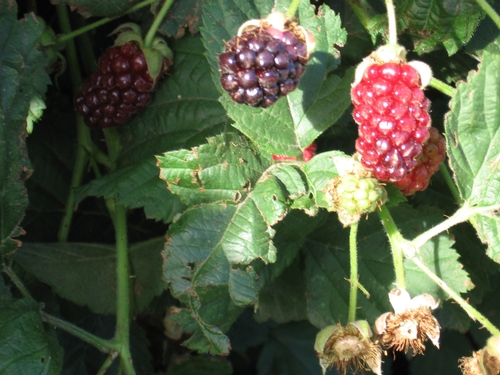Posts Tagged: blackberries
Can less water grow better berries?
It might be pouring rain today, but soon enough California will be dry again. As demand for water for a growing urban population and for environmental restoration increases, farmers throughout the state are working to grow crops using as little water as possible, and UC is working with them.
"Water supplies are being constrained. Farmers are facing reduced access to water," said Shermain Hardesty, a UC Cooperative Extension specialist in the Department of Agricultural and Resource Economics at UC Davis.
The research involves using some elaborate formulas for determining how much water is needed. UCCE advisor Richard Molinar, working with small farms in Fresno County, is irrigating small plots of strawberries with different amounts of water, some at 125 percent of the normal rate, some at 100 percent, and others at 75 percent and 50 percent of normal. In San Diego County, UCCE advisor Ramiro Lobo is doing similar research on strawberries and blueberries; UCCE advisor Manuel Jimenez is working with blackberries and blueberries in Tulare County; UCCE advisor Aziz Baameur is planting strawberries and blackberries in Santa Clara County, and UCCE advisor Mark Gaskell is studying blackberries in Santa Barbara County.
Once the berries are grown, they need to be tested - and testing means tasting in this project. The research team is holding tasting sessions to let the public judge which berries they prefer. If you've ever tasted a dry-farmed tomato, you might guess the answer. The first tasting session was held at the Davis Farmers' Market in June, with seven more coming soon at farmers' markets and grocery stores around the state.
Taste is a great quality to measure, but only one aspect of the study. Berries are already known for having a high nutrient content, but growing them with less water might give them even higher nutritional value. The team expects to find nutrition density to be highest at the lowest irrigation levels. To test this concept, UCCE specialists Elizabeth Mitcham and Marita Cantwell, experts in postharvest science affiliated with the Department of Plant Sciences at UC Davis, are doing nutritional quality analysis of the berries as they are picked.
Because they have to deal with so many variables, from weather to pests to unexpected competition and volatile prices, farmers are often called gamblers. Because of all these uncertainties, farmers are likely to try to control what they can. Research team member Lawrence Schwankl, a UCCE specialist in the Department of Land, Air and Water Resources at UC Davis, says that many farmers are currently over-watering many crops.
"Over-irrigation is cheap insurance, especially for such high value crops," he said.
He explained that more water tends to grow bigger berries. Since the harvest is not mechanized for berry crops, it takes as much effort to pick a small berry as a large berry, making more efficient use of the pickers' time and filling the basket more quickly if the berries are bigger.
Such a trade-off for the farmers! The public may decide that they prefer smaller berries with more taste, and the scientists may decide that smaller berries are more nutritious, but will it be profitable to grow better berries? It may depend on how much smaller, and on how much less water for how much better nutrition and taste. It may depend on the water rates, says Hardesty. She will be taking all of these variables into account to determine the potential impact on profitability of lower irrigation rates on berries.
The team, which also includes UCCE advisors Michael Cahn in Monterey County and David Shaw in San Diego, will report the results of their study to California farmers in the final year of the project. This project is funded by a California Department of Food and Agriculture Specialty Crop Block Grant.
U-pick organic strawberry season opens on coast
The U-pick strawberry fields at Swanton Berry Farm near Davenport on the coast are formally opening on May 28, but if you drive out there now, you’ll get a chance to pick without a crowd. Talking to Barrett Boaen, the U-pick manager, I got to the bottom of just why their berries, also sold at local Whole Foods stores, look and taste so good.
Partly it’s the ‘Chandler’ variety, chosen for its old-fashioned sweetness and flavor although it yields only about two-thirds as well as some varieties. It’s also about not pumping up production with too much nitrogen or irrigation (more details here). Mostly, though, it’s about the picking process. A strawberry grower visiting from the East Coast recently bought two flats from the farmstand, saying he couldn’t help himself, he had never laid eyes on such beautiful organic berries, and he knew who to congratulate—the pickers.
You and I are unlikely to come close to picking as well as Swanton’s unionized employees, some of whom have more than 20 years of experience at the farm. They recognize when a strawberry is as ripe as it can be, when it’s red and sweet all the way through (strawberries don’t continue ripening once they are picked). Although a less ripe berry is firmer, with a longer shelf-life and easier to transport, it has less flavor, so the pickers wait a day or two for any berry with a green tip or white shoulders to ripen perfectly. They discard berries that are soft on one side (from raindrops settling on the fruit) or have a cat-face look, which is lygus bug damage.
Moving along the rows, which are banked up to 18 inches high to reduce back strain, they harvest each perfectly ripe berry, with its green calyx attached, in a “twist and flick” motion: “you put tension on the stem above the calyx, and rotate it, so you can see 360 degrees and whether there’s any damage to the berry; then with just the right tension, the berry will pop off naturally,” explains Boaen.
In the U-pick fields, which have ocean views, visitors pick for pleasure, hopping from row to row, enjoying the fresh air, and the fragrance of the berries and the earth. Compared to the serious work in the other 20 acres of strawberries, “the 3 acres of U-pick are a playground,” says Boaen, “We provide people everything they need to be happy.”
“It can be demoralizing,” Boaen admits. “All that energy put into the fruit after the excellent warm January was wrecked.”
Fortunately, the farm has several other crops, and the strawberry fields are filling with new berries. You can pick them this summer for $2.50 per pound (10 percent discount for bicyclists). Bring your own containers if you remember, a windproof jacket and boots in case of fog or mud, and most of all, Boaen recommends allowing plenty of time to enjoy yourself.
By mid-June, Swanton ollalieberries will be ripe, and by mid- or late July, the blackberries will be ready. Farm tours are available by reservation. Organic strawberry and ollalieberry jams, and five other kinds, are available at the farmstand or online.

Swanton's farmstand
It's blackberry and boysenberry pickin' time
Blackberries and boysenberries are amazing fruits. The fleeting fruit bearing nature of these productive plants are to be truly appreciated by pie and jam connoisseurs alike. Berries are a very low glycemic index foods (low in sugar) and a great treat for nutritionally conscious eaters.
Every gardener can enjoy and/or hate a productive berry plant. The fruit production is confined to a very short season but the plant can take on enormous proportions if left unchecked. One must be ever diligent to keep the berry plants confined to the planting row and kept trellised to avoid the “overgrown” berry heap in the backyard. Nonetheless, if a person has a place in the sun for a four-foot-wide row of berries, the rewards are terrific.
One can even plant them on south facing wal
l as long as you can put up a sturdy supporting trellis. If you live in a very hot summer climate, it may pay to cover your berry plants with a shade cloth, especially during ripening.From one plant you can harvest enough berries for a batch of delicious jam, or a luscious pie, some fruit for breakfast and, my favorite, blackberry popsicles (recipe to follow). After harvest, cut the berry canes that have already produced fruit back to the ground and trellis up those new canes growing up from the bottom. If you do that on an annual basis, you will keep the plants under control.
There are many varieties of berries and planting several with varying ripening periods spreads the harvest out over a longer time. Many varieties have a unique flavor, different from the “wild blackberry” that you may remember from the plant growing in the ditch. Some are thornless and easier to manage and others are quite thorny but the flavor is to die for.
Berries are divided into two groups: the trailing blackberries and erect blackberries. Trailing blackberries such as Boysen and Ollalie are popular varieties that are just now becoming ripe in Northern California. I have also been growing three of the erect cultivars that require a quite tall trellis - upwards of six to seven feet. But the fruit on these types are very large, and beautiful and the plants are vigorous and disease resistant. The varieties are “Black Satin," “Triple Crown” and “Cherokee.” These varieties will become ripe in another couple of weeks.
For more information on growing blackberries in your garden, visit the California Gardening website.
While you can use the berries in many ways, one that is truly a delight is to make blackberry popsicles. Here is the recipe:
Start by making a simple syrup by heating 2/3 cup of water to boiling, pour in 2/3 cup of white cane sugar and stir until dissolved. Remove from heat and allow to cool. Put three cups of washed fresh berries into a bowl and mash. You may want to strain out the seeds by pushing the fruit through a strainer, but you don’t need to. Blend with the cooled simple syrup. (You can also just put the berries into a blender with 2/3 cup of simple syrup.)
Pour the mixture into your popsicle mold and freeze for 3 to 4 hours. Insert the popsicle sticks and freeze 3 to 4 hours more. When frozen solid, take a popsicle in hand, mosey your way out to the garden, sit in a lounge chair in the shade and lick your troubles away.




